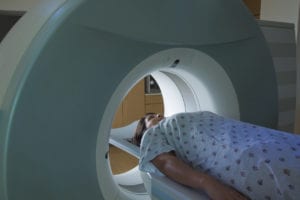
A practitioner may recommend you receive a magnetic resonance imaging (MRI) or computerized tomography (CT) scan to diagnose certain health conditions or monitor a current health issue. While the tests are similar in nature, your doctor may want you to have one as opposed to the other, depending on the purpose of the test. At Starling Diagnostics, we’re an advanced imaging center that offers both types of tests and would like to take a moment to educate you about them.
MRIs
An MRI machine aligns the water molecules in your body to generate images on a computer screen. Once the machine aligns the water molecules, it uses radio waves to create signals to produce the images. An MRI machine can create cross-sectional images of different parts of your body. It can also create images in different angles due to the machine’s size and structure. To get an MRI done, you lie on a flat, stretcher-like surface that moves into a large tube-like machine. The MRI can be taken in different angles because the structure is all around your body. MRI scans are painless and fairly quick.
CT Scans
A CT scan produces cross-sectional images of different parts of your body, just like an MRI. This test takes X-rays, which use electromagnetic radiation that can pass through your body. The body parts that the X-rays can’t pass through absorb the energy, which is how they show up on the scan. They absorb energy differently, hence the different colored structures on the X-ray images.
During the test, you lie on a flat surface and enter the machine that has an X-ray tube and detectors. The tube and detectors rotate to capture images of your internal body structures. Although it uses the same technology as a standard X-ray, a CT scan can provide a practitioner with much more detailed images than an X-ray.
Uses
Both MRIs and CTs have different uses, while there is some overlap.
MRIs
MRIs take detailed images of tissues and organs. Although a doctor may order them for various parts of your body, they’re particularly beneficial for evaluating the brain and spinal cord. For instance, a doctor may order an MRI to evaluate you for brain or spinal cord tumors. They can also order an MRI to look for nerve damage from multiple sclerosis. Additionally, an MRI can help detect spinal cord disorders, assess for signs of stroke, and diagnose brain injuries.
In terms of other parts of your body, an MRI can help doctors diagnose infections, joint and disc abnormalities, tumors, heart attack damage, aneurysms, and much more.
CT Scans
A CT scan allows doctors to obtain images of your soft tissues, blood vessels, and bones. A physician may order a CT scan of a bone to look for a tumor or fracture. It’s also beneficial to look for tumors in other parts of your body.
Doctors may order a CT to look for blood clots or internal bleeding, as well. CT scans are often employed to help detect, diagnose, and monitor conditions like cancer and heart disease. Sometimes, a contrast dye may be used to produce better quality CT scan images. The dye helps highlight different areas of your body.
Choose Our Advanced Imaging Center in Bronx, NY
Starling Diagnostics offers a variety of radiology services like CT and MRI scans, so we can be your one-stop-shop for all your diagnostic imaging needs. Our team understands that these tests can be nerve-racking, so we take the time to make you feel comfortable and relaxed. We also take every step necessary to ensure your imaging is accurate, so there is no need for repeat testing.
Book an appointment with Starling Diagnostics, serving the Bronx and the nearby region, for a CT or MRI scan by calling (718) 319-1610 or using our online appointment request form.
